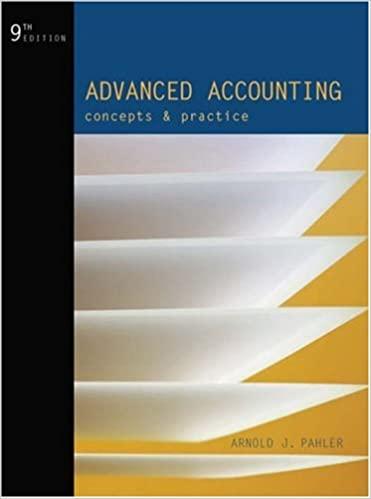(Module 1 only) Consolidation Worksheet: Cost Method The comparative financial statements of Pylo Inc. and its 100%-owned...
Question:
(Module 1 only) Consolidation Worksheet: Cost Method The comparative financial statements of Pylo Inc. and its 100%-owned subsidiary, Sylo Inc. (created seven years ago), follow:
Pylo Inc. Cost Method®
Equity Method'’
Sylo Inc. Income Statement (2006)
Sales . . $ 700,000 $ 700,000 $ 250,000 Cost of sales . . (430,000) (430,000) (130,000)
Expenses . . (170,000) (170,000) (90,000)
Dividend income (from Sylo) . . 10,000 Equity in net income (of Sylo) . 30,000 Net Income . . $ 110,000 $ 130,000
$
30,000 Balance Sheet (as of 12/31/06)
Cash . . $ 45,000
$ 45,000
$
Accounts receivable, net . . 95,000 40,000 95,000 55,000 Inventory . . 170,000 170,000 75,000 Investment in subsidiary . . 50,000 130,000 Property and equipment . . 280,000 280,000 175,000 Accumulated depreciation . . (120,000) (120,000) (25,000)
Total Assets . . $ 520,000 $ 600,000 $ 320,000 Payables and accruals . . $ 140,000 $ 140,000
$ 70,000 Long-term debt . . 300,000 300,000 120,000 Common stock . . 10,000 10,000 50,000 Retained earnings . . 70,000 150,000 80,000 Total Liabilities and Equity . . $ 520,000 $ 600,000 $ 320,000 Dividends declared in 2006 . . $ 90,000
$ 90,000
$ 10,000
“ Use this column for working the problem under the cost method, as called for in this problem.
Use this column for working the problem under the equity method, as called for in Problem 2-4.
1 Prepare all consolidation entries as of 12/31/06.
2 Prepare a consolidation worksheet at 12/31/06.
3 What is the maximum dividend the parent can declare ($70,000 or $150,000) if cash were avail¬ able?
Step by Step Answer:






